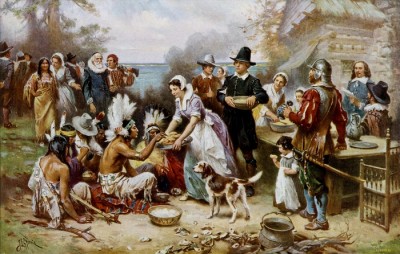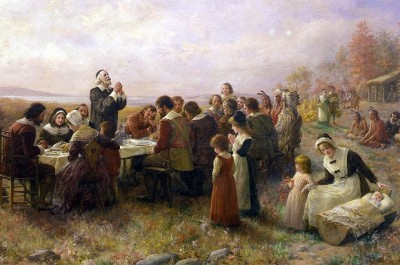 I have read with interest a recent excellent article by Debra G Miller in the current issue of the Society of Mayflower Descendants in the Commonwealth of Pennsylvania Newsletter, and felt moved to add to it my own simple observation.
I have read with interest a recent excellent article by Debra G Miller in the current issue of the Society of Mayflower Descendants in the Commonwealth of Pennsylvania Newsletter, and felt moved to add to it my own simple observation.
In Debra’s words:
The First Thanksgiving …we have seen it printed in our history books, museums, paintings, literature, and in our homes to name a few. We have talked about it, passed the tradition on from generation to generation. You probably even have a painting replicating this national holiday in your home. Do you call it The [First] Thanksgiving? If you do you need to think again.
Henry Hornblower, the founder of Plimoth Plantation, could not have said it better: “A myth associated with the 1621 harvest celebration at Plymouth. Historians at Plimoth Plantation do NOT use this name because what happened in 1621 wasn’t a part of how our modern Thanksgiving was started.” — Plimoth Plantation, 1997, Plimoth Plantation, A Pictorial Guide, Fort Church Publishers, Inc., R.I.
There are only two primary sources that reference the post-harvest gathering in 1621 at Plymouth. One appears in William Bradford’s Of Plymouth Plantation, much of which may have been written quite sometime after the events he recorded. The other appears in the booklet Mourt’s Relation (full title: A Relation or Journal of the Beginning and Proceedings of the English Plantation Settled at Plimoth in New England and believed to have been published by George Morton). And it is this account written by Edward Winslow that we can be assured of as being absolutely contemporary as it was published in London in 1622 and within months of the event so often taken as being the “First Thanksgiving.”
Winslow wrote:
Our harvest being gotten in, our governor sent four men on fowling, that so we might after a special manner rejoice together, after we had gathered the fruits of our labours; they four in one day killed as much fowl, as with a little help beside, served the Company almost a week, at which time amongst other Recreations, we exercised our Arms, many of the Indians coming amongst us, and amongst the rest their greatest king Massasoit, with some ninety men, whom for three days we entertained and feasted, and they went out and killed five deer, which they brought to the Plantation and bestowed on our Governor, and upon the Captain and others.
Winslow’s final remark — “And although it be not always so plentiful, as it was at this time with us, yet by the goodness of God, we are so far from want, that we often wish you partakers of our plenty” — remains a sentiment shared by many American at today’s Thanksgiving celebrations.
What Were The True Motives?
Lost or simply forgotten during the Colonial period, around 1820 antiquarian Reverend Alexander Young rediscovered this passage and included the text in his Chronicles of the Pilgrim Fathers (1841). Young had immediately latched on to a similarity between his contemporary American Thanksgiving and this 1621 Harvest-time feast and thus this tradition came into the public mind-set. Celebrations and acts of thanksgiving, both secular and religious in nature, were not something new or unique to our Pilgrim settlers while living in England and in Holland or indeed to earlier New World Colonists. Therefore, to refer to the poorly recorded and ambiguous events relating to the Pilgrims harvest in 1621 as being the “First Thanksgiving” is somewhat misleading.
Awaken Your Child’s Love of Learning, History And Adventure With The REAL Story of William Wallace!
Instead, today’s Thanksgiving celebration should be viewed as a hybrid of two traditions: an age-old and culture-wide custom of rejoicing in a successful harvest, and the Puritan religious observance of Thanksgiving combining prayer and communal feasting
If not a representation of an act of thanksgiving after the completion of the colony’s first harvest, then what was it that Winslow was trying to convey? Why pick this event to write about, amongst so many others presumably playing out, if of no significance? Perhaps also instead of placing our attention purely upon the events of this account – that of a peaceful, pleasant interaction between the Plymouth colonists and their Native American neighbors – we should also look at why and when this account was first made public.
The original front piece of Mourt’s Relation bears the publication date of 1622. Under the Julian Calendar, by which England and its colonies were still operating, New Year’s Day fell on March 25 (Lady Day or the Feast of the Annunciation). Therefore Mourt’s Relation was published at some time after this date.
Horror In Jamestown
On Friday, March 22 1621/22 something utterly cataclysmic had happened in the New World colony of Jamestown, and it had shaken London to its core. That morning, Native American braves had come unarmed into the colonists’ houses with deer, turkeys, fish, fruits and other provisions to trade when suddenly they had seized any English tools or weapons that came to hand and killed as many settlers as they could – women and children included. Thus in this well-coordinated series of surprise attacks 347 people, a quarter of the English population of Jamestown, were massacred. A report after the attack noted:
Not being content with taking away life alone, the fell again upon the dead, making as well as they could, a fresh murder, defacing, dragging, and mangling the dead carcasses into so many pieces, and carrying some parts away in derision, with base and brutish triumph…
 News of the dreadful attack did not reach England until mid-July 1622 when a ship called the Seaflower arrived from Virginia, bearing grim reports of the attack. As a result English gentleman investors, members of Parliament, and clergy alike were now suddenly forced to reconsider the whole idea of co-existence with Native Americans in the New World. For those involved in the Virginia Company, the murderous events of March 22 demanded total and bloody revenge. Pieces quickly published that summer set the new tone and English attitude against the Native Americans. For the first time the Virginia Company’s own literature characterized Native American as “these beasts” or worse than beasts and adding:
News of the dreadful attack did not reach England until mid-July 1622 when a ship called the Seaflower arrived from Virginia, bearing grim reports of the attack. As a result English gentleman investors, members of Parliament, and clergy alike were now suddenly forced to reconsider the whole idea of co-existence with Native Americans in the New World. For those involved in the Virginia Company, the murderous events of March 22 demanded total and bloody revenge. Pieces quickly published that summer set the new tone and English attitude against the Native Americans. For the first time the Virginia Company’s own literature characterized Native American as “these beasts” or worse than beasts and adding:
Because our hands which before were tied with gentleness and faire usage, are now set at liberty by the treacherous violence of the savages, not untying the knot, but cutting it: So that we, who hitherto have has possession of no more ground than their waste, and our purchase at valuable consideration to their own contentment, gained; may now by right of war, and law of nations, invade the country, and destroy them who sought to destroy us: whereby we shall enjoy their cultivated places, turning the laborious mattock (hoe) into the victorious sword…
Captain John Smith entered the fray and setting pen to paper he wrote to the Virginia Company:
If you please I may be transported with a hundred soldiers and thirty sailors by the next Michaelmas, with victual, munition, and such necessary provision, by God’s assistance, we would endeavour to enforce the savages to leave their country, or bring them in that fear and subjection that every man should follow their business securely…
The proposed venture did not go ahead because the Virginia Company simply had not the funds to back it. However, the company did immediately send 42 barrels of gunpowder, and King James made a huge gift of armaments himself to the colonists.
Trying To Ease Tempers In London?
And so it was that juxtaposed amongst a wrath of tracts, books and pamphlets expounding the brutal and wicked nature of the Native American and a growing hatred at home in England and the Virginia colony against them, Mourt’s Relation quietly painted a peaceful scene of harmony and coexistence at the colony of Plymouth.
In his letter Edward Winslow had continued:
We have found the Indians very faithful in their covenant of peace with us; very loving and ready to pleasure us; we often go to them, and they come to us; some of us have been fifty miles by land in the country with them, the occasions and relations whereof you shall understand by our general and more full declaration of such things as are worth the noting, yea, it has pleased God so to possess the Indians with a fear of us, and love unto us, that not only the greatest king amongst them, called Massasoit, but also all the princes and peoples round about us, have either made suit unto us, or been glad of any occasion to make peace with us, so that seven of them at once have sent their messengers to us to that end. Yea, an Isle at sea, which we never saw, hath also, together with the former, yielded willingly to be under the protection, and subjects to our sovereign lord King James, so that there is now great peace amongst the Indians themselves, which was not formerly, neither would have been but for us; and we for our parts walk as peaceably and safely in the wood as in the highways in England. We entertain them familiarly in our houses, and they as friendly bestowing their venison on us. They are a people without any religion or knowledge of God, yet very trusty, quick of apprehension, ripe-witted, just. The men and women go naked, only a skin about their middles.
So was this the real message hoped to be conveyed by the recording of that gathering after the harvest of 1621 in Plymouth? Was Winslow’s simply a letter from a friend far off in the New World to another left behind in England? Or as sometimes reported, was this particular account published without the permission of its author? Had George Morton, on the ground in London as the dreadful accounts of the Jamestown massacres unfolded, acted on the spur of the moment to publish the contents of this and other letters in an attempt to allay the fears of the merchant-adventurer backers of the Plymouth venture and future colonists necessary to secure the colony’s very existence? Was this incidental account of an act of celebration over the harvest and shared by the Pilgrims with their new neighbors instead pressed into use by Morton as a part of a much more larger testament to, and justification for, a continuing and peaceful coexistence of the Plymouth colony with its Native American neighbors which might also do much to counter the bitter hatred even then at large in London and being instilled in the minds of future colonists who might even then be making ready to depart the old England for the new? Is it possible that this London-based agent of the Pilgrims was actively attempting to protect their indigenous friends from future violence by a new rash of incomers?
The letter written by Edward Winslow and included in Mourt’s Relation is dated “Plymouth in New England this 11th of December, 1621” — just two days before the Fortune left for England. The Fortune arrived back in London on February 17, 1622, barely a month before the Jamestown attacks.
In London and armed with favorable letters and correspondence from his friends in Plymouth, had Gorge Morton published Mourt’s Relation as an immediate response and defense of Plymouth’s Native American neighbors against the sudden and widespread backlash of hatred among his countrymen aimed towards the indigenous people of the New World in the wake of the Jamestown massacre? Or was the timing of the release of Mourt’s, as soften witnessed in the Pilgrim story, purely down to divine providence?
If not an account of the First Thanksgiving, what can we take from Mourt’s snap shot in time sketched out in Winslow’s slight words and scant detail which nonetheless have imparted a deep and lasting impression? It is simply this: Almost 400 years ago by divine providence cultures divided by an ocean briefly came together in Eden and in a time of plenty sat down together to revel in each other’s company and to share the spoils of their joint good fortune in the spirit of peace and friendship. Perhaps it is this lost moment in time that still lives on somewhere deep in a shared psyche and that there is this scene yet to truly recreate in the Eden still that is America.
What are your thoughts? Do you consider the Pilgrims’ feast the “first Thanksgiving”? Leave your reply in the section below:
 Off The Grid News Better Ideas For Off The Grid Living
Off The Grid News Better Ideas For Off The Grid Living



